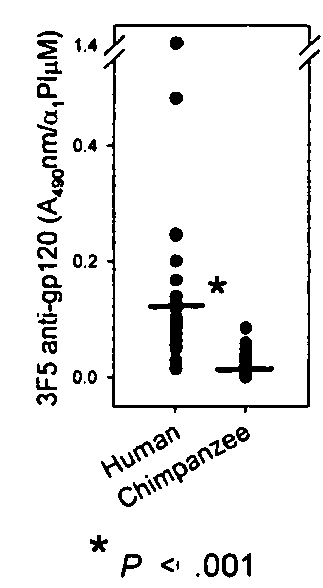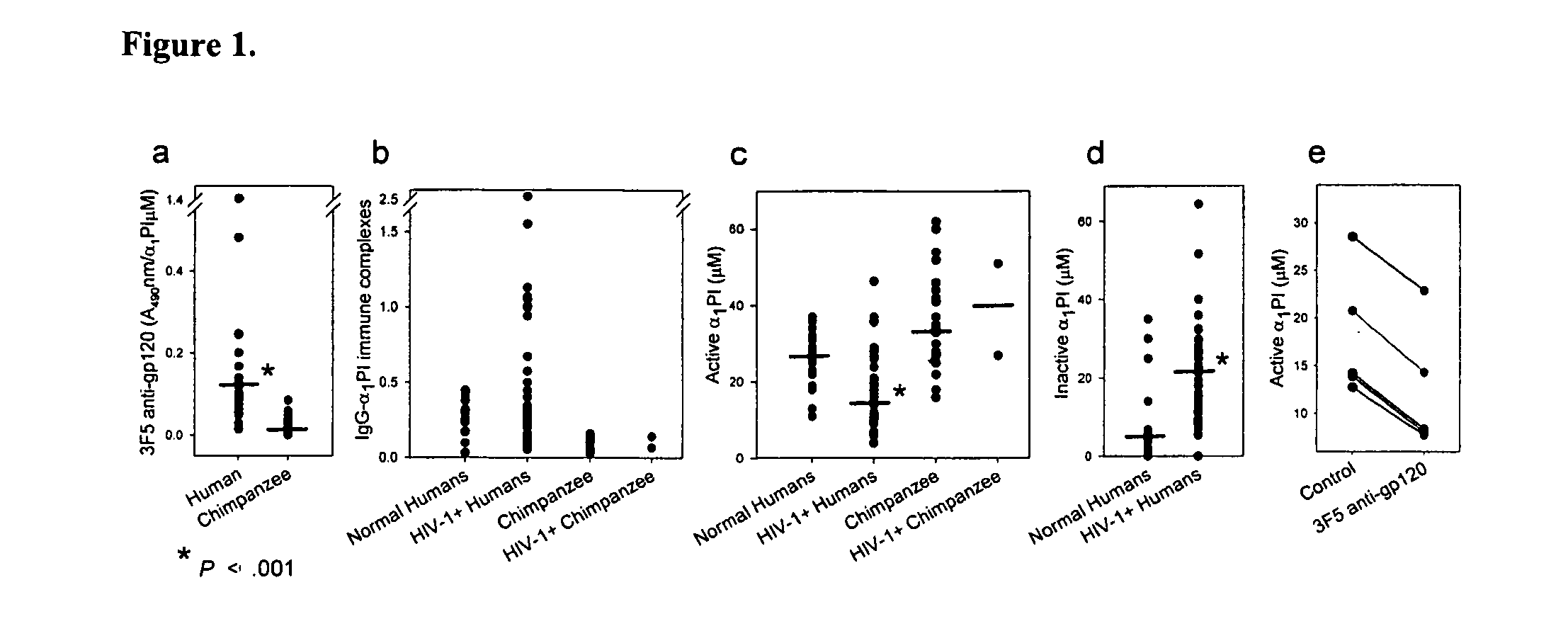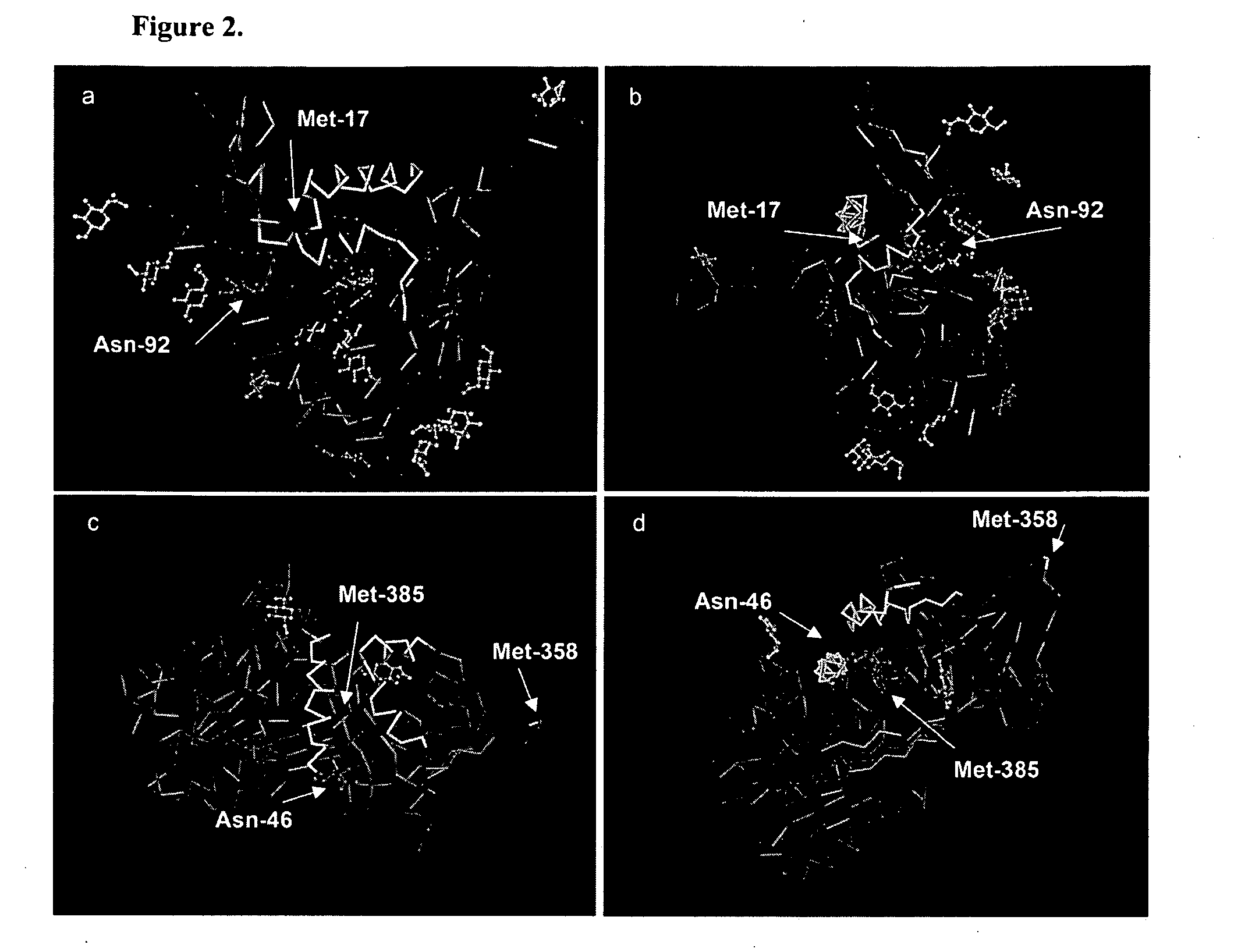Alpha1 proteinase inhibitor peptides methods and use
a proteinase inhibitor and peptide technology, applied in the field of alpha1 proteinase inhibitor peptide methods and use, can solve the problems of time involvement and expense, and achieve the effect of increasing cd4 lymphocyte renewal
- Summary
- Abstract
- Description
- Claims
- Application Information
AI Technical Summary
Benefits of technology
Problems solved by technology
Method used
Image
Examples
example 1
[0232]Monoclonal anti-gp120 binds human, but not chimpanzee α1PI. Two monoclonal antibodies (1C1 and 3F5) which bind a conformationally determined epitope near the C5 domain of gp12049 were found to also bind human α1PI26. It was hypothesized that anti-gp120 mediated depletion of active α1PI might be pathognomonic for HIV-1 AIDS. If true, chimpanzee α1PI should differ from human α1PI since HIV-1 infected chimpanzees survive infection and regain normal levels of CD4+ lymphocytes50. Sequence comparison revealed that human α1PI differs from chimpanzee α1PI by one amino acid (aa 385) caused by a single nucleotide change (NCBI accession numbers BT019455 and XP—522938), and this aa difference lies in the gp120-homologous region of α1PI. To determine whether this sequence difference affects the binding of anti-gp120 to α1PI, 20 human and 20 chimpanzee sera were compared.
[0233]Both 1C1 (data not shown) and 3F5 exhibited 8- to 14-fold greater binding to human, than chimpanzee α1PI in 6 repea...
example 2
[0240]Active α1PI is rate limiting for CD4+ lymphocytes in HIV-1 disease. Of the 36 patients included in the study population, 23 were below 500 and 13 were above 500 HIV RNA copies / ml at the time of blood collection. All patients were measured for CD4, CXCR4, CCR5, SDF-1 levels, active and inactive α1PI. Only 28 of these patients were additionally measured for HLECS. Neither CXCR4 nor CCR5 were found to correlate individually or in combination with any parameters of disease being investigated in these patients. Eleven of the 38 HIV-1 patients had active liver disease as defined by detectable Hepatitis B or C, or elevated liver enzymes. HIV-1 patients with liver disease were not different from patients without liver disease in active α1PI (p=0.95), total α1PI (p=0.79), CXCR4 (p=0.63), or CCR5 (p=0.9), but exhibited significantly higher SDF-1 (pCS+ lymphocytes (p+ lymphocytes (p=0.04).
[0241]In the 23 patients with + lymphocyte levels were correlated with higher active (α1PI concentra...
example 3
[0242]α1PI augmentation therapy in HIV-1 infected patients. The number of CD4+ T lymphocytes in patients with 1PI (Example 3). These patients have below normal levels of circulating α1PI26. Approximately 10% clinic patients in New York City who have1PI augmentation by increasing their CD4+ T lymphocyte numbers. Treatment of HIV-1 infected patients with α1PI augmentation is indicated in patients who are simultaneously receiving one or a combination of the four currently known classes, nucleoside reverse transcriptase inhibitors, non-nucleoside reverse transcriptase inhibitors, HIV-1 aspartyl protease inhibitors, and fusion inhibitors.
[0243]Three patients with 1PI augmentation therapy. Patients received weekly infusions of Zemaira® at 120 mg / kg. Treatment outcome was monitored as described herein. Specifically, patients receiving ZEMAIRA were monitored weekly for changes in active and inactive α1PI levels as well as for CD4+ T lymphocytes and other subsets of circulating blood cells. ...
PUM
| Property | Measurement | Unit |
|---|---|---|
| Molar density | aaaaa | aaaaa |
| Composition | aaaaa | aaaaa |
| Therapeutic | aaaaa | aaaaa |
Abstract
Description
Claims
Application Information
 Login to View More
Login to View More - R&D
- Intellectual Property
- Life Sciences
- Materials
- Tech Scout
- Unparalleled Data Quality
- Higher Quality Content
- 60% Fewer Hallucinations
Browse by: Latest US Patents, China's latest patents, Technical Efficacy Thesaurus, Application Domain, Technology Topic, Popular Technical Reports.
© 2025 PatSnap. All rights reserved.Legal|Privacy policy|Modern Slavery Act Transparency Statement|Sitemap|About US| Contact US: help@patsnap.com



